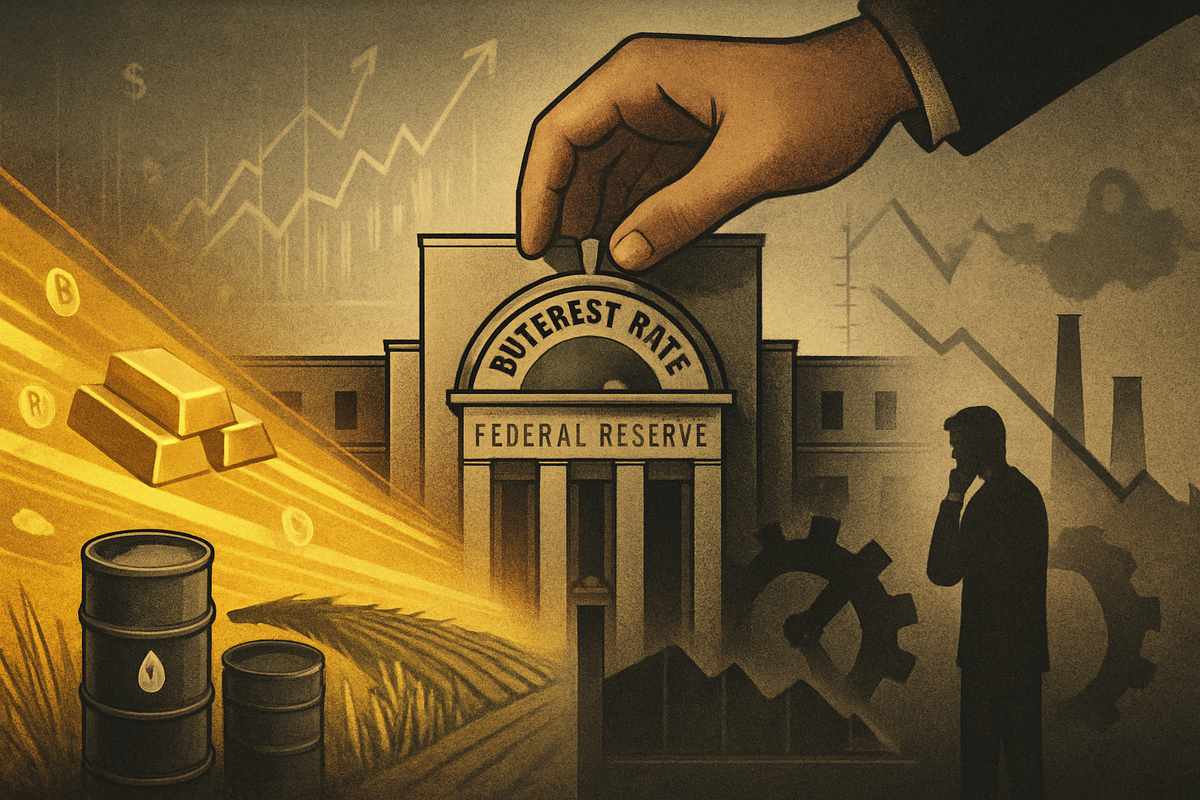
The Federal Reserve's recent pivot towards interest rate cuts, initiated in September 2025 and with further reductions anticipated, is sending complex signals through global commodity markets. While the promise of cheaper credit aims to stimulate economic activity and bolster demand for raw materials, these very cuts are largely a response to underlying growth concerns, particularly a weakening U.S. labor market. This delicate balancing act creates a nuanced outlook, where some commodities, notably precious metals, are soaring, while others face a more uncertain path, caught between the tailwinds of monetary easing and the headwinds of economic fragility.
This strategic shift in monetary policy, coming after a period of holding rates steady, injects liquidity into the financial system and typically weakens the U.S. dollar, making dollar-denominated commodities more attractive to international buyers. However, the efficacy of this stimulus is being closely watched, as the market grapples with the Federal Reserve's dual mandate of managing inflation—which remains above its 2% target—and fostering maximum employment. The current environment, therefore, presents a fascinating study in market dynamics, where investor sentiment, geopolitical stability, and the actual pace of economic recovery will dictate the ultimate winners and losers in the commodity landscape.
The Fed's Dovish Pivot: A Detailed Timeline
The Federal Reserve has embarked on a significant easing cycle, a marked departure from its previous stance. The current trajectory of rate cuts began in September 2024 with a 50-basis-point reduction, followed by additional 25-basis-point cuts in October and November 2024, and another in December 2024, bringing the federal funds rate to 4.25%-4.50%. After a nine-month pause through early 2025, the Federal Open Market Committee (FOMC) resumed its rate-cutting path on September 16-17, 2025, lowering the federal funds rate by 25 basis points to a target range of 4.00%-4.25%. This move was primarily driven by increasing concerns over a softening U.S. labor market, despite inflation remaining somewhat elevated.
Market expectations are firmly set for another 25-basis-point cut at the upcoming FOMC meeting on October 28-29, 2025, which would bring the rate to 3.75%-4.00%. The Fed has signaled two more cuts for the remainder of 2025, with J.P. Morgan Global Research anticipating further reductions extending into 2026. Key players in these decisions include Chairman Jerome H. Powell, who characterized the September cut as a "risk management cut," and other FOMC members like Stephen I. Miran, who advocates for even more aggressive easing. This dovish shift has already had a palpable impact on commodity markets. Gold, for instance, surged nearly 12% in September 2025 to an all-time high of $3,859 per ounce, driven by lower real interest rates and its safe-haven appeal. Silver mirrored this rally, gaining 17.44% in September. Industrial metals, particularly copper, have also shown strong performance, contributing to a year-to-date gain exceeding 10% in the Bloomberg Commodity Total Return Index by late September 2025. However, energy commodities like crude oil and agricultural products face more mixed signals, grappling with oversupply concerns and the disruptive impact of the ongoing U.S. government shutdown on data reporting and price discovery.
Winners and Losers: Corporate Fortunes in a Lower-Rate Environment
The Federal Reserve's interest rate cuts are creating a distinct bifurcation in corporate fortunes across the commodity sector. Companies that are capital-intensive or benefit from a weaker dollar and heightened investor risk appetite are poised to gain, while others may face headwinds if underlying economic weakness persists or specific market dynamics work against them.
Mining companies, particularly those focused on precious metals, are among the clearest beneficiaries. Gold and silver miners, such as Barrick Gold Corporation (NYSE: GOLD) and Newmont Corporation (NYSE: NEM), stand to gain significantly from surging precious metal prices. Lower interest rates reduce the opportunity cost of holding non-yielding assets like gold, driving up demand. Additionally, as mining operations often require substantial upfront capital for exploration and development, cheaper credit directly reduces borrowing costs, enhancing profitability and making new projects more viable. Industrial metal miners, like those producing copper, also benefit from increased demand spurred by cheaper credit for manufacturing and construction.
In the energy sector, the picture is more nuanced. Renewable energy companies, with their heavy reliance on project financing, are set to benefit from reduced capital costs. Firms like Sunnova Energy International Inc. (NYSE: NOVA) and Sunrun Inc. (NASDAQ: RUN) could see accelerated project development and increased consumer adoption as financing becomes more affordable. Traditional oil and gas companies, while potentially benefiting from overall economic stimulation, may face mixed impacts. While lower rates can support demand, concerns about global oversupply and geopolitical tensions can cap price increases. Companies like Exxon Mobil Corporation (NYSE: XOM) and Chevron Corporation (NYSE: CVX), identified as being positively correlated with yields, might see relative underperformance if rates decline, depending on their specific debt structures and market exposures.
Agriculture companies could also see varied effects. Farmers benefit from lower interest rates on operating loans, potentially improving cash flow and investment in equipment. A weaker dollar also makes U.S. agricultural exports more competitive. However, if rate cuts are a response to a broad economic slowdown, and commodity prices for certain crops remain depressed due to oversupply, the benefits of cheaper credit might be offset by reduced revenues. Companies supplying agricultural inputs, such as Deere & Company (NYSE: DE) for farm equipment, could face reduced demand if farmers' profitability is squeezed. Conversely, industrial and construction-related companies that consume commodities, such as Caterpillar Inc. (NYSE: CAT) and homebuilders like PulteGroup Inc. (NYSE: PHM), D.R. Horton, Inc. (NYSE: DHI), and Lennar Corporation (NYSE: LEN), are expected to see a boost from lower borrowing costs stimulating infrastructure and housing projects, thereby indirectly driving demand for industrial metals and other construction materials.
Broader Ripples: Global Economic Shifts and Historical Echoes
The Federal Reserve's interest rate cuts are not merely a domestic policy adjustment; they send ripple effects across the global economy and commodity markets, fitting into broader trends of de-dollarization, inflation management, and international trade dynamics. The decision to ease monetary policy, largely in response to a weakening U.S. labor market, carries significant implications for competitors, partners, and regulatory landscapes worldwide.
One major ripple effect is the weakening of the U.S. dollar. As the Fed lowers rates, the dollar typically depreciates, making dollar-denominated commodities cheaper for foreign buyers. This can stimulate demand from countries using other currencies, boosting commodity prices globally. However, for countries heavily reliant on dollar-denominated imports, this could mean higher import costs and potential inflationary pressures. This trend also plays into the broader narrative of de-dollarization, as persistently high gold prices, partly fueled by Fed policies, encourage central banks globally to diversify their reserves away from the dollar, fostering a more multipolar financial system.
Historically, Fed rate cuts have often coincided with increased commodity demand. During the 2008 financial crisis, for instance, aggressive rate cuts eventually led to a surge in prices for gold and oil once market confidence began to recover. Gold, in particular, has a strong historical precedent of performing well during easing cycles, averaging about an 8.4% higher return nine months after a cut. This is largely due to the inverse relationship between real yields and the investment demand for gold as a non-yielding asset. However, the context of the cuts matters significantly. Commodities perform "really, really well" during "benign" cutting cycles—characterized by global expansion with moderating inflation and subdued job growth. Conversely, if cuts are a response to an impending recession, commodities have historically averaged about a 16% negative return over the following six to nine months, as seen in 2001 and 2009.
Regulatory and policy implications also abound. A Fed rate cut can trigger a global monetary policy shift, prompting other central banks to consider their own easing measures to maintain currency competitiveness and support their economies. This collective easing can alleviate global economic pressure but may also escalate global debt levels. Policymakers also face renewed pressure to manage inflation, especially if commodity price surges, fueled by rate cuts, contribute to persistent inflationary pressures. The effectiveness of these cuts in stimulating the real economy might also be more lagged than in the past, due to factors like many households holding low-rate mortgages (reducing refinancing waves) and a "slow hire, slow fire" labor market. The ongoing U.S. government shutdown in early October 2025 further complicates the economic outlook by delaying crucial data releases, adding another layer of uncertainty to Fed deliberations and potentially intensifying safe-haven demand for assets like gold.
The Road Ahead: Navigating Commodity Markets in an Easing Cycle
The Federal Reserve's ongoing interest rate cuts are setting the stage for a dynamic period in commodity markets, presenting both clear opportunities and significant challenges. The short-term outlook is generally positive for many commodities, driven by cheaper credit, a weaker U.S. dollar, and increased investor appetite for riskier assets. However, the long-term trajectory will largely depend on whether the Fed's easing successfully engineers a "soft landing" for the economy or if deeper recessionary pressures or persistent inflation take hold.
In the short term, precious metals are expected to maintain their strong momentum. Gold and silver, having already reached record highs, are likely to continue their ascent, fueled by lower real interest rates, ongoing geopolitical uncertainties, and robust central bank buying. Gold is projected to reach $4,100-$4,300 per ounce in the near term, with silver also maintaining its bullish trend. Industrial metals, particularly copper, are also poised for continued strength, benefiting from global economic stimulus and strong demand from the electric vehicle (EV) and infrastructure sectors. Aluminum prices have climbed to six-month highs, and further upside is anticipated. However, crude oil prices, despite the stimulus, may remain relatively steady or even face downward pressure due to oversupply concerns and increasing production from OPEC+. Agricultural commodity prices, while benefiting from lower borrowing costs for farmers, are broadly forecast to decline in 2025 due to robust harvests.
Looking longer term, the key determinant will be the underlying economic scenario. In a "Bronzeilocks" (benign cutting cycle) environment, characterized by global expansion that avoids severe recession, commodities have historically performed very well, led by energy and precious metals. However, if the rate cuts are a precursor to a recession—a risk estimated at 40% over the next 12 months—commodities could see negative returns. A significant challenge remains the potential for persistent inflation. If rate cuts exacerbate inflationary pressures, forcing the Fed to reverse course, it would introduce considerable volatility. Conversely, a "renewed inflation" scenario, with sticky inflation above target, could see commodities perform exceptionally well as inflation hedges. The long-term demand for "green energy metals" like lithium and copper, driven by the global energy transition, remains robust, with lower rates facilitating investment in new projects.
Strategic pivots and adaptations will be crucial for market participants. Investors should consider reallocating portfolios towards commodities, leveraging dollar weakness, and seeking inflation hedges. Diversification across various commodity classes and alternative investments is essential. For commodity producers, financial resilience, operational efficiency, and sophisticated hedging strategies will be paramount. Energy companies, in particular, may need to accelerate diversification into new energy sources, while farmers must manage credit carefully, balancing cheaper short-term operating loans against potentially rising long-term debt costs. Emerging market economies, especially those with export-oriented sectors, could benefit from increased capital flows and a more competitive dollar.
Emerging market opportunities include the continued rally in precious metals, strong demand for green energy metals, and reduced capital costs for energy projects. Challenges include the risk of persistent inflation or a full-blown recession, continued oversupply in crude oil markets, and potential underperformance of certain base metals. Geopolitical tensions and market volatility around Fed messaging will also remain significant factors.
Navigating the New Normal: A Comprehensive Market Wrap-up
The Federal Reserve's current trajectory of interest rate cuts, initiated in September 2025 and expected to continue into early 2026, marks a pivotal moment for global financial markets, particularly commodities. The central bank's dovish pivot, driven by concerns over a weakening labor market and a desire to stimulate economic growth, creates a complex interplay of forces that demand careful consideration from investors.
Key takeaways from this period of monetary easing include the broad support it offers to commodity markets through cheaper credit and a weaker U.S. dollar. Precious metals, especially gold and silver, have emerged as clear beneficiaries, soaring to record highs due to their appeal as inflation hedges and safe-haven assets in a low-yield environment. Industrial metals like copper and aluminum are also poised for sustained demand, fueled by global growth, AI/data center expansion, and decarbonization efforts. However, the outlook for energy commodities like crude oil remains tempered by oversupply concerns, even amidst the stimulative effects of lower rates.
Moving forward, the market's trajectory will be heavily influenced by whether the Fed's actions lead to a "soft landing"—a scenario of sustained growth with moderating inflation—or if the underlying economic weaknesses culminate in a recession. The risk of persistent inflation, despite rate cuts, also looms large, potentially creating a "run-it-hot" market where tangible assets perform well. The lasting impact of this easing cycle is likely to be a broadly supportive environment for many commodities, potentially contributing to higher inflation over the long term and reshaping asset valuations.
For investors, the coming months necessitate an agile and strategic approach. It is advisable to deploy capital wisely, diversifying portfolios to include commodity beneficiaries. Focus on precious metals for their hedging capabilities and industrial metals for their leverage to global growth and the energy transition. Palladium also presents near-term opportunities. Crucially, investors must closely monitor key economic indicators such as labor market data, inflation reports, U.S. dollar strength, and geopolitical developments, as these will be instrumental in shaping the Fed's future decisions and their ripple effects across commodity prices. Awareness of potential risks, including a full-blown recession or the persistence of inflation, is paramount. This period of monetary easing is not a guarantee of universal gains across all commodities, but rather an environment where selective positioning and vigilant monitoring will be key to navigating the evolving landscape.
This content is intended for informational purposes only and is not financial advice


















